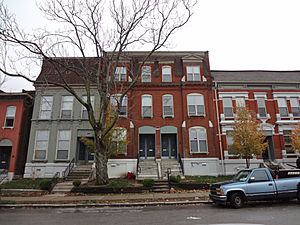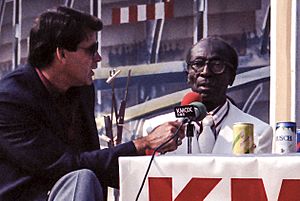Cool Papa Bell facts for kids
Quick facts for kids Cool Papa Bell |
|||
|---|---|---|---|
 |
|||
| Center fielder / Pitcher | |||
| Born: May 17, 1903 Starkville, Mississippi, U.S. |
|||
| Died: March 7, 1991 (aged 87) St. Louis, Missouri, U.S. |
|||
|
|||
| debut | |||
| 1922, for the St. Louis Stars | |||
| Last appearance | |||
| 1946, for the Homestead Grays | |||
| Negro leagues statistics | |||
| Batting average | .325 | ||
| Hits | 1,548 | ||
| Home runs | 57 | ||
| Runs batted in | 596 | ||
| Win–loss record | 20–15 | ||
| Earned run average | 4.53 | ||
| Strikeouts | 146 | ||
| Teams | |||
|
|||
| Career highlights and awards | |||
|
|||
| Induction | 1974 | ||
| Election Method | Negro Leagues Committee | ||
James Thomas "Cool Papa" Bell (born May 17, 1903 – died March 7, 1991) was an American baseball player. He played as a center fielder and pitcher in the Negro leagues and the Mexican League from 1922 to 1946. Many people think he was one of the fastest players ever in baseball. He was chosen for the Baseball Hall of Fame in 1974. In 1999, The Sporting News magazine listed him as the 66th greatest baseball player of all time.
Contents
Early Life and First Steps in Baseball
James Bell was born on May 17, 1903, in Starkville, Mississippi. When he was 17, he moved to St. Louis, Missouri, to live with his older brothers. He planned to go to high school at night. However, he spent most of his time playing baseball in his neighborhood.
He joined a Black semi-pro team called the Compton Hill Cubs as a knuckleball pitcher. A semi-pro team means players get paid, but it's not a fully professional league. Bell played with them on Sundays and holidays. In 1922, he moved to the East St. Louis Cubs, another semi-pro team, where he earned $20 a week to pitch on Sundays.
A Star in the Negro Leagues
Joining the St. Louis Stars
In 1922, Bell joined the St. Louis Stars in the Negro National League (NNL) as a pitcher. He got his famous nickname "Cool Papa" in his first season. He was called "Cool" after he struck out a great player named Oscar Charleston. The "Papa" was added because it sounded better.
At first, Bell only played in the outfield sometimes. But by 1924, his manager, Bill Gatewood, encouraged him to play more in the outfield. Bell eventually became a full-time center fielder and stopped pitching. He also learned to bat as a switch hitter, meaning he could hit with both his right and left hands. Hitting left-handed made him even faster when running to first base.
Bell's Amazing Speed
Bell was known for his incredible speed. Even though his throwing arm wasn't super strong, his speed allowed him to play very close to home plate in the outfield. He could still catch balls hit far behind him.
Pitchers tried not to let Bell get on base because he could often steal both second and third base. He could even score a run from first base if the batter got a base hit. Bell once said that Negro league teams played "tricky baseball" against white teams. They would do unexpected things like bunt early in the game, then hit away when the other team expected a bunt. They ran the bases hard to make fielders rush and make mistakes.
Bell helped the St. Louis Stars win league championships in 1928, 1930, and 1931. He played with his good friend Willie Wells and first baseman Mule Suttles.
Moving to Other Teams
When the NNL stopped in 1932, Bell played for the Detroit Wolves in the East-West League. This league also ended because of low attendance during the Great Depression. Bell then played for the Kansas City Monarchs and in the Mexican League.
He later found a home with the Pittsburgh Crawfords in the new NNL. In Pittsburgh, he was part of what many consider the best outfield in the Negro leagues, playing with Ted Page and Jimmie Crutchfield. The 1936 Crawfords team had six players who later joined the Baseball Hall of Fame.
Playing in Latin America
In 1937, Bell left the Crawfords because the owner didn't pay the players. Bell, Satchel Paige, and other Crawfords players went to the Dominican Republic. They played for a team put together by the country's leader, Rafael Trujillo. Trujillo wanted his team to win the championship to show his power.
The players felt a lot of pressure to win. One story says that after a loss, an army officer warned the team not to lose again. Some players were very scared. However, the team won the league championship.
Bell then played in the Mexican League from 1938 to 1941. This league allowed players of all races. He played for teams in Tampico, Torreón, and Veracruz. In 1940, Bell made history by winning the Triple Crown in the Mexican League. This means he led the league in batting average (.437), home runs (12), and runs batted in (79). He also had 167 hits that year. His team, Veracruz, won the championship. Bell's career batting average in the Mexican League was an amazing .367.
Return to the United States and Retirement
Bell came back to the United States in 1942 to play for the Chicago American Giants. In 1943, he joined the Homestead Grays in the NNL. The Grays won league championships in Bell's first two seasons. In 1946, at 43 years old, Bell hit an impressive .396 for the Grays.
After his playing days, Bell became a player-manager for Negro league farm teams until 1950. He ended his Negro league career with a .341 batting average. In exhibition games against Major League Baseball (MLB) players, he hit .391. Bell also worked as a part-time scout for the St. Louis Browns from 1951 to 1954.
Legends of Speed
Bell was known as one of the fastest players in baseball history. His teammate, Satchel Paige, used to tell a funny story about Bell's speed. He said Bell was so fast that he could turn off the light switch and be in bed before the room got dark!
Another legend says Bell once hit a ball up the middle of the field and was hit by the ball himself as he slid into second base. In a documentary called Baseball, it was said that Bell once scored from first base on a sacrifice bunt. He was so fast that he rounded third base and scored before the other team could react. Bell once ran around the bases in 13.1 seconds on a wet field and claimed he could do it in 12 seconds on a dry field.
His teammate Ted Page said that Bell was a very good person off the field. He was honest, kind, and lived a clean life.
Later Life and Legacy
After his baseball career, Cool Papa Bell lived in St. Louis. He worked as a security officer and custodian at St. Louis City Hall until 1970. In 1974, he was inducted into the Baseball Hall of Fame. His Hall of Fame plaque mentions that other players thought he was the fastest runner on the bases. He was the fifth Negro league player to be inducted.
Cool Papa Bell passed away on March 7, 1991, after a heart attack. His wife, Clara, had died a few weeks before him. To honor him, the street where he lived in St. Louis was renamed James "Cool Papa" Bell Avenue. He was also added to the St. Louis Walk of Fame. There is a Cool Papa Bell Drive leading to the Mississippi Sports Hall of Fame and Museum in Jackson.
The St. Louis Cardinals baseball team has a bronze statue of him outside their stadium, Busch Stadium. It stands alongside statues of other famous St. Louis baseball stars.
Cool Papa Bell has been mentioned in books and movies. He was also honored by the Washington Nationals Ring of Honor in 2010 for his contributions to baseball. In 2021, Mississippi State University unveiled the Cool Papa Bell Plaza and a mural honoring him.
In August 2022, a harness racing horse named Cool Papa Bell won a big race called the Hambletonian, causing a huge surprise.
On May 30, 2024, Major League Baseball officially recognized the statistics from the Negro Leagues as part of MLB's historical records. This means Cool Papa Bell's amazing stats are now officially part of MLB history.
Images for kids
See also
 In Spanish: Cool Papa Bell para niños
In Spanish: Cool Papa Bell para niños





